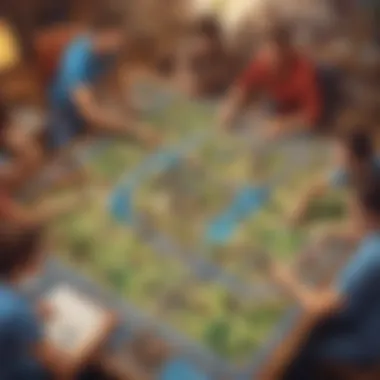Ultimate Guide on Crafting Your Custom Video Game with Expert Tips


Designing Your Video Game
Before you embark on the exciting journey of creating your own video game, it's crucial to have a clear plan in mind. Designing your game involves brainstorming ideas, sketching out characters and settings, and outlining the gameplay mechanics. This initial phase sets the foundation for your entire project and helps you visualize the end product. Don't rush this step; take the time to flesh out your concepts and refine them to ensure a solid starting point.
Gameplay Mechanics and Storyline Development
Once you have a solid design in place, it's time to delve into the gameplay mechanics and storyline development. Think about how players will interact with your game, what challenges they will face, and how the narrative will unfold. Creating a compelling storyline that complements the gameplay is essential for engaging players and immersing them in your game world. Consider incorporating unique mechanics that set your game apart from others in the market.
Programming and Coding the Game
The next crucial phase in creating your video game is programming and coding. This step requires technical expertise as you transform your design and storyline into a functional game. Whether you're using a game development platform or coding from scratch, attention to detail is key. Debugging and testing are integral parts of this process, ensuring that your game runs smoothly and is free of glitches. Learning to code can be challenging but immensely rewarding as you see your game come to life.
Testing and Debugging Your Game
Once the programming is complete, thorough testing and debugging are essential to refine your game further. Testing involves playing the game multiple times to identify bugs, glitches, or balancing issues. Player feedback is also invaluable during this stage, helping you fine-tune gameplay elements for a more enjoyable experience. Dedicate sufficient time to testing to ensure a polished final product that meets your standards and player expectations.
Launching Your Video Game
Finally, the moment you've been waiting for – launching your video game! Before releasing your game to the public, create a marketing strategy to generate buzz and attract players. Consider different platforms for distribution, such as app stores or online game portals. Building a community around your game through social media and forums can help create a loyal fan base. Be prepared to receive feedback post-launch and continue updating and improving your game based on player responses. With dedication and perseverance, your video game can make a mark in the gaming industry.
Introduction
In the realm of video game creation, the introduction serves as the gateway to a fascinating universe of possibilities. It lays the foundation for embarking on an exhilarating journey of game development, encompassing planning, design, programming, testing, and eventual launch. Novices and seasoned developers alike can glean invaluable insights from this guide to craft their unique game concepts into tangible digital experiences.
Understanding Game Development
Diving deeper into understanding game development unveils a realm teeming with creativity and complexity. Exploring the Basics provides a fundamental framework essential for comprehending game design intricacies. Decoding Game Design unravels the intricacies of creating captivating gameplay experiences, while Importance of Programming sheds light on the critical role of code in shaping the gaming landscape.
Choosing a Game Concept
Among the pivotal stages lies selecting a game concept that resonates with both creators and players. Identifying Your Audience is a strategic step in tailoring gaming experiences to specific demographics. Brainstorming Ideas kindles the spark of innovation, fostering a fertile ground for creative ideation. Incorporating Innovation injects freshness and novelty into game concepts, setting them apart in a competitive market.
Planning Your Game
Planning lays the groundwork for transforming abstract ideas into cohesive game projects. Creating a Game Design Document is akin to crafting a blueprint, outlining every aspect of the game's vision. Setting Realistic Goals ensures the project stays on track, fostering a sense of tangible progress. Establishing a Timeline brings order to chaos, delineating milestones and deadlines to steer the development process seamlessly.


Development Phase
Developing a video game involves a crucial stage known as the Development Phase, which encapsulates the actual creation and implementation process. This phase is where the game transitions from concept to reality, encompassing various elements such as game design, programming, art, and sound. The Development Phase forms the backbone of the entire game development process by turning ideas and plans into interactive gameplay experiences, ensuring that the game aligns with the initial vision and objectives set during the planning stage.
Game Design
Building Game Mechanics
Building Game Mechanics constitutes a fundamental aspect of game design, as it involves structuring the rules and interactions within the game world. The key characteristic of Building Game Mechanics lies in its ability to define how players engage with the game, encompassing elements such as controls, objectives, challenges, and feedback mechanisms. This strategic choice in game design is essential for shaping the overall player experience, as it directly affects gameplay dynamics and player engagement levels. Implementing strategic or innovative game mechanics can significantly enhance the game's appeal and replay value; however, striking a balance between complexity and user-friendliness is critical to ensure a positive player experience.
Designing Characters and Worlds
Designing Characters and Worlds is a pivotal aspect of game development that adds depth and immersion to the gaming experience. This process involves creating memorable characters, developing detailed environments, and weaving engaging narratives that captivate players. The key characteristic of Designing Characters and Worlds lies in its capacity to evoke emotional connections and establish a unique identity for the game. By meticulously crafting characters with distinct personalities and designing immersive worlds with rich lore and aesthetics, developers can transport players into a vibrant and interactive gaming universe. However, ensuring consistency in character design, world-building, and narrative coherence is essential to maintaining player engagement and fostering a cohesive gaming experience.
Storyboarding
Storyboarding plays a crucial role in visualizing and planning the flow of the game's narrative and gameplay elements. The primary characteristic of Storyboarding is its ability to outline the sequence of events, interactions, and challenges that players will encounter throughout the game. By structuring the game's progression through storyboards, developers can map out key moments, user experiences, and level designs, ensuring a cohesive and engaging gameplay journey. Storyboarding serves as a blueprint for game development, enabling teams to align their creative vision and technical requirements, iterate on gameplay concepts, and refine the overall player experience. However, maintaining flexibility in the storyboard to accommodate creative enhancements or gameplay optimizations is essential to adapting to player feedback and evolving development needs.
Programming
Choosing a Game Engine
Choosing a Game Engine is a pivotal decision in game development, as it dictates the tools, resources, and capabilities available to developers. The key characteristic of Choosing a Game Engine lies in its role as the foundation for the game's technical framework, providing essential functionalities such as rendering, physics, audio, and more. This strategic choice determines the development workflow, performance optimizations, cross-platform compatibility, and overall efficiency of the game production process. Selecting a game engine that aligns with the project scope, team expertise, and target platform requirements is crucial for streamlining development tasks, fostering collaboration, and maximizing productivity. However, evaluating the learning curve, licensing fees, support services, and community resources of different game engines is essential to making an informed decision and ensuring long-term project success.
Writing Code
Writing Code is an integral aspect of game programming that involves creating algorithms, logic, and functionalities to bring the game to life. The key characteristic of Writing Code lies in its ability to translate game design concepts into executable instructions that define gameplay mechanics, user interfaces, artificial intelligence, and more. This process requires proficiency in programming languages such as C++, C#, Java, or Python, as well as familiarity with industry best practices, coding standards, and optimization techniques. Writing clean, efficient, and well-documented code is essential for ensuring code readability, maintainability, and scalability throughout the game development lifecycle. However, embracing coding conventions, version control systems, debugging tools, and code refactoring practices is crucial for minimizing errors, improving code reusability, and enhancing overall code quality.
Implementing Gameplay Features
Implementing Gameplay Features involves integrating and refining interactive elements that shape the player experience and game dynamics. The key characteristic of Implementing Gameplay Features lies in its capacity to enhance player engagement, immersion, and interactivity by introducing mechanics such as combat systems, progression systems, puzzles, or social interactions. This iterative process of feature implementation requires attention to detail, playtesting feedback, and gameplay balancing to ensure that each game element contributes to the overall cohesiveness and enjoyment of the gaming experience. Iterative refinement based on player feedback, analytics data, and design iterations is essential for optimizing gameplay features, fixing usability issues, and adjusting difficulty levels to create a compelling and rewarding player journey.
Testing and Refinement
Testing and Refinement play a crucial role in the game development process as they ensure the quality and functionality of the game before launch. In this phase, developers focus on identifying and rectifying any bugs or issues, refining gameplay mechanics, and integrating player feedback for iterative improvements.
Quality Assurance


Quality Assurance encompasses various crucial elements that contribute to the success of a video game. It consists of Bug Testing, Feedback Integration, and Iterative Improvement to enhance the overall gaming experience and meet player expectations.
Bug Testing
Bug Testing is a pivotal aspect of Quality Assurance as it involves systematically identifying and resolving software bugs or errors within the game. By conducting thorough bug testing, developers can enhance the game's stability and performance, ensuring a seamless gaming experience for players. Its meticulous approach to detecting and fixing bugs makes Bug Testing a fundamental practice in the game development process.
Feedback Integration
Feedback Integration involves incorporating player feedback into the game design to enhance user experience and address any concerns or suggestions raised by the gaming community. By embracing feedback, developers can make informed decisions on refining gameplay elements, adjusting difficulty levels, or adding new features based on player preferences. This iterative process fosters player engagement and loyalty, ultimately shaping the game's success.
Iterative Improvement
Iterative Improvement focuses on continuous enhancements and refinements throughout the game development cycle. Developers systematically analyze player feedback, performance data, and industry trends to implement incremental changes that optimize gameplay mechanics, visuals, and overall game experience. This iterative approach ensures that the game evolves organically, reflecting the developers' commitment to delivering a polished and engaging final product.
Launch and Distribution
In the grand scheme of game development, the Launch and Distribution phase holds immense significance. This pivotal stage marks the culmination of extensive planning, creative efforts, and technical execution, leading up to the moment of unveiling your masterpiece to the gaming community. Launch and Distribution encompass the crucial steps that transform your game from a personal project into a product ready to reach a global audience.
Publishing Your Game
Selecting Platforms
The aspect of Selecting Platforms plays a fundamental role in the success and reach of your game. Choosing the right platform can significantly impact the visibility and accessibility of your creation. Whether opting for mobile devices, consoles, or PC, each platform choice comes with unique considerations and opportunities. Selecting Platforms strategically involves analyzing the target audience, platform compatibility, and market trends to maximize exposure and engagement.
Marketing Strategies
Marketing Strategies form the backbone of promoting and positioning your game in the competitive gaming market. Crafting effective marketing campaigns, utilizing social media platforms, and collaborating with influencers are key tactics to enhance visibility and attract a loyal player base. Engaging storytelling, captivating visuals, and interactive teasers contribute to creating a buzz around your game, generating anticipation and interest among the gaming community.
Release Planning
Release Planning orchestrates the timing and execution of introducing your game to the world. Strategically scheduling the launch date, coordinating press releases, and optimizing distribution channels are integral aspects of an effective release strategy. With meticulous planning and anticipation building, a well-executed release can generate momentum, drive initial player engagement, and set the stage for long-term success.
Community Engagement
Building a Player Base
Building a Player Base involves fostering connections and interactions with potential players to cultivate a dedicated community around your game. Engaging with early adopters, soliciting feedback, and organizing beta testing can help build excitement and loyalty among players. Establishing a strong player base lays the foundation for ongoing support, word-of-mouth promotion, and sustained interest in your game.


Managing Community Forums
Managing Community Forums serves as a hub for communication, feedback, and player collaboration. Creating a supportive and interactive online space enhances player engagement, encourages discussions, and provides a platform for sharing updates and announcements. Monitoring forums, addressing player concerns, and fostering a positive community culture are essential for nurturing a vibrant and loyal player community.
Update and Expansion Plans
Update and Expansion Plans involve continuously evolving and enhancing your game to meet player expectations and market demands. Developing post-launch content, addressing player feedback, and implementing new features keep the gameplay fresh and engaging. Strategic updates and expansions breathe new life into your game, retain existing players, and attract new audiences, ensuring the long-term success and sustainability of your gaming project.
Monetization
Choosing Revenue Models
Choosing Revenue Models entails deciding on the monetization strategy that aligns with your game concept and target audience. Whether opting for premium purchases, subscription models, or in-game advertising, selecting the right revenue model can impact the financial viability and player reception of your game. Balancing player experience with revenue generation is crucial for creating a sustainable and profitable gaming ecosystem.
Implementing In-Game Purchases
Implementing In-Game Purchases involves integrating microtransactions and virtual goods within your game to offer players additional content and features for a fee. Strategically implementing in-game purchases requires transparency, fairness, and value proposition to ensure player satisfaction and retention. Careful design and implementation of in-game purchase systems can enhance player engagement and contribute to the overall monetization strategy.
Advertising Opportunities
Advertising Opportunities present avenues for promoting and monetizing your game through partnerships, sponsorships, and ad placements. Leveraging advertising opportunities on platforms, social media, and gaming websites can increase brand visibility, attract new players, and generate additional revenue streams. Identifying the right advertising channels, creating compelling ad content, and targeting the relevant audience are key elements in maximizing the impact of advertising initiatives.
Conclusion
In the final section of this comprehensive guide on creating your very own video game, we delve into the crucial aspect of reflecting on your journey. After traversing the intricate paths of game development, taking time to reflect becomes paramount. This introspective phase allows developers to analyze their decisions, successes, and areas for improvement. Through reflection, one can distill valuable insights that pave the way for future projects. It serves as a blueprint for growth and enhancement in the dynamic realm of game creation.
Moving forward, contemplating future game development goals emerges as a pivotal step. Setting clear objectives and ambitions propels developers towards innovation and excellence. This section encourages aspiring game creators to envision the trajectory of their careers, identifying milestones and aspirations. By delineating tangible goals, developers can plot a roadmap to success and steer their creative endeavors with purpose and direction.
Last but not least, fostering a culture of continued learning permeates every successful game developer's journey. Embracing ongoing education and skill enhancement ensures relevance and adaptability in an ever-evolving industry. By staying abreast of new technologies, trends, and methodologies, developers can push boundaries and challenge conventions. Continued learning serves as a catalyst for creativity and progress, nurturing a mindset of perpetual growth and mastery in the realm of game development.
Final Thoughts
Reflecting on Your Journey
Diving into the realm of reflecting on your journey offers a profound opportunity for introspection and growth. This practice allows creators to review their decisions, actions, and outcomes, fostering a deeper understanding of their development process. Revisiting past experiences provides valuable lessons and insights that shape future endeavors, contributing to a holistic approach to game creation.
Future Game Development Goals
Exploring the realm of future game development goals brings forth a realm of possibilities and aspirations for budding developers. By setting clear and actionable goals, creators can leverage their strengths and interests to carve a distinct path in the gaming industry. Establishing long-term objectives instills a sense of purpose and direction, igniting the passion and drive needed to achieve success in this competitive landscape.
Continued Learning
Delving into the sphere of continued learning underscores the significance of perpetual growth and self-improvement in game development. Embracing new skills, technologies, and methodologies opens doors to innovation and creativity, fostering a sustainable career in the gaming industry. By fostering a mindset of continuous education, developers can adapt to industry changes and remain at the forefront of gaming trends, ensuring relevance and longevity in their endeavors.







